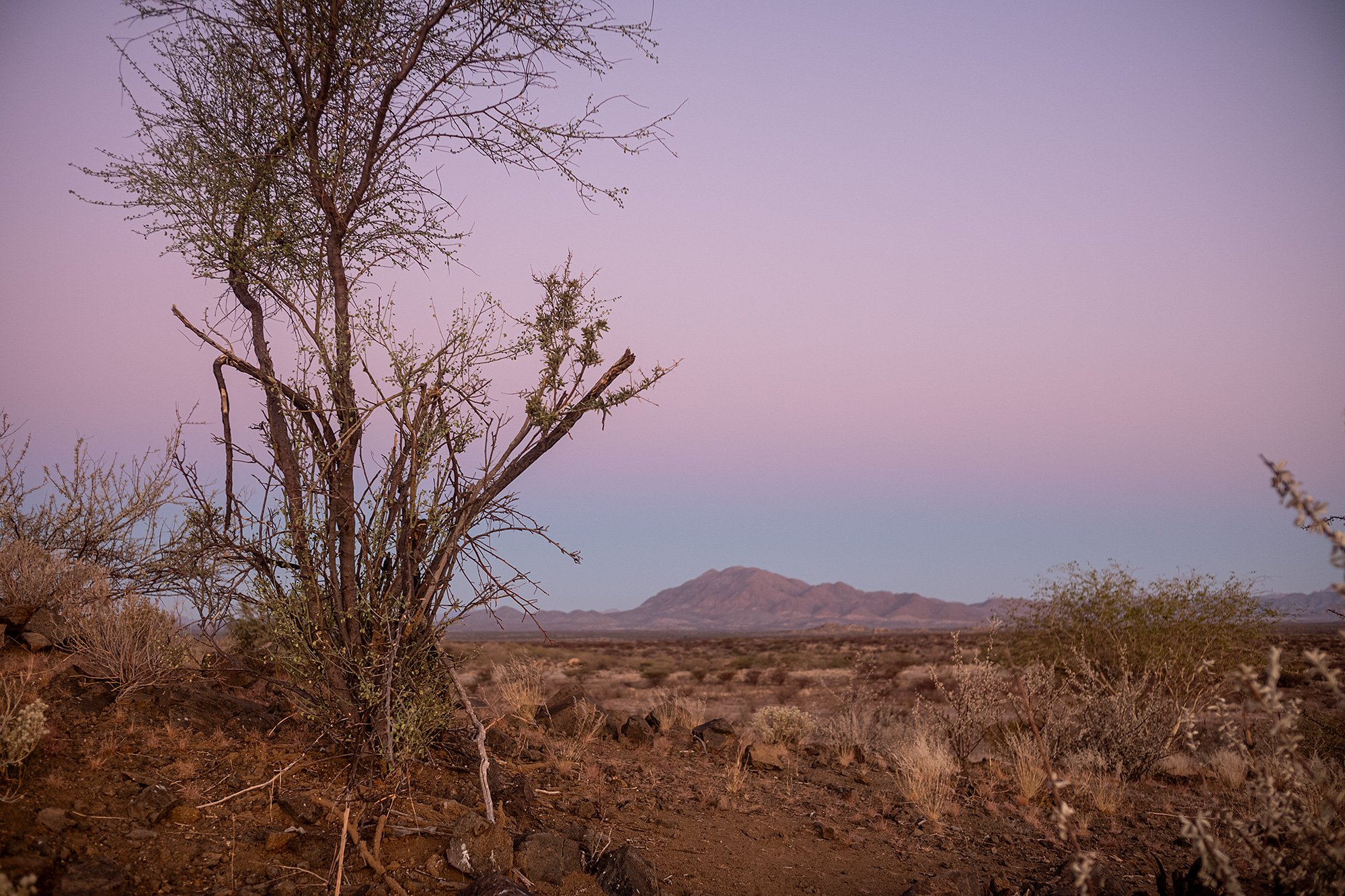
Namibia chapter seventeen
A day at Spitzkoppe (and an afternoon at the foot of the Erongo massif).
I’m up early, eager to get a jump on the day. It’s two hours to Spitzkoppe and then another hour to the lodge in which I’m staying. It’s all been a last-minute addition to my itinerary and I’m not entirely certain what to expect.
After a quick breakfast I take my bags to the car. The tire pressure in the left rear wheel looks a little low. I drive to a gas station and ask them if they can refill the tire; their pump is broken. I drive to another and ask if they can help. They tell me it looks like a puncture.
They brush water onto the tire with a squeegie and ask me to drive forward a bit, spreading water on the surface. Soon we see it bubble; it’s a small puncture by the tire’s rim.
No sooner have I asked if they can fix it than I find one attendant under the car, lowering the spare. Another digs out the jack so that they can lift the car. I ask if they can repair the tire. I want to make sure both spares are in working order just in case. I’m lead into the store. Fessy points out a tire repair kit and I take it to the counter to purchase it.

By the time I’m back out in the lot the tires are being switched. Fessy takes the repair kit and rolls the tire towards the buckets of water used for washing windows. He repeats the process of brushing water onto the tire until he locates the puncture and gets to work, mixing the glue, threading a plug through the needle, and thrusting it through the hole. He’s done in less than ten minutes.
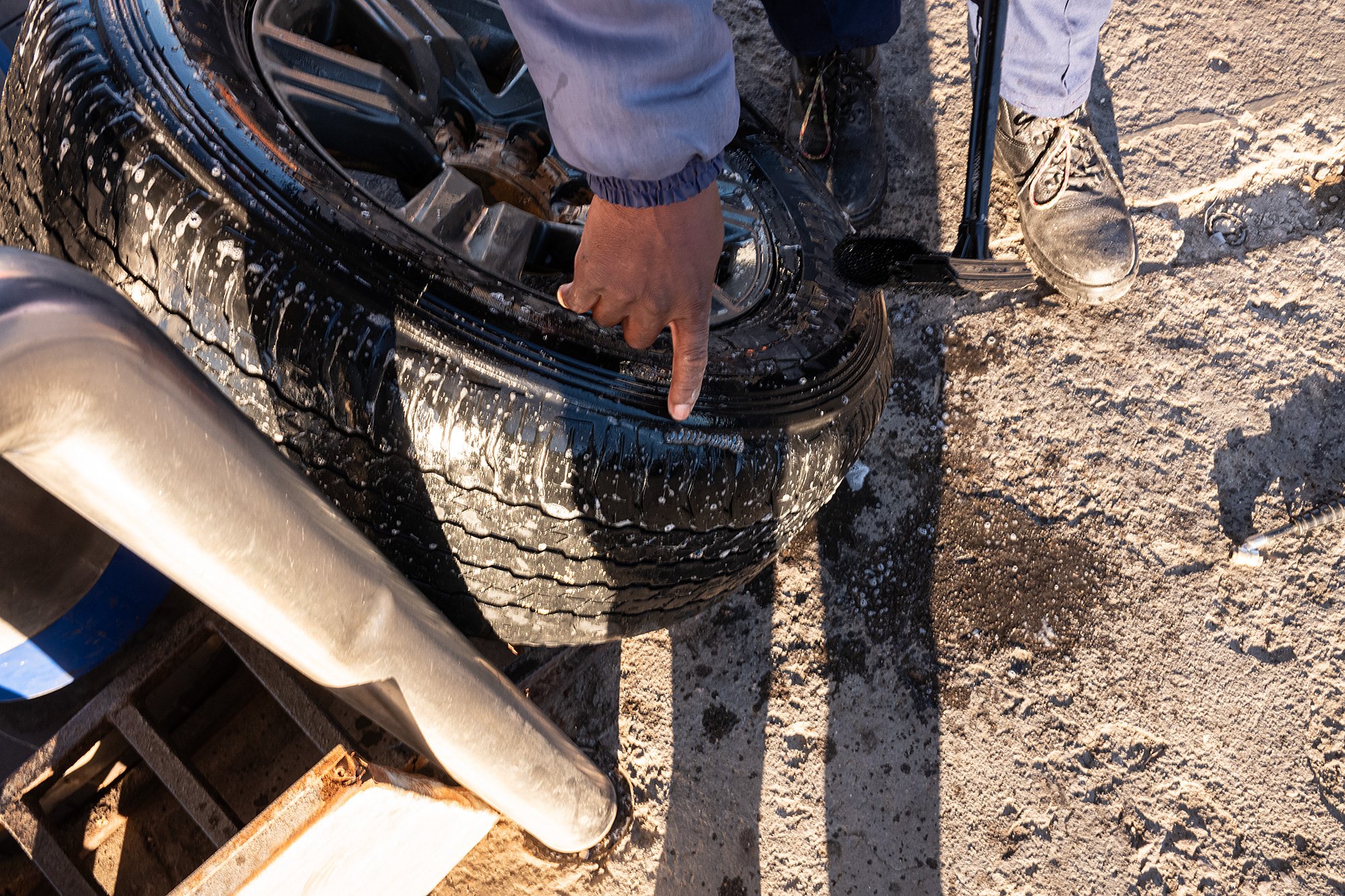
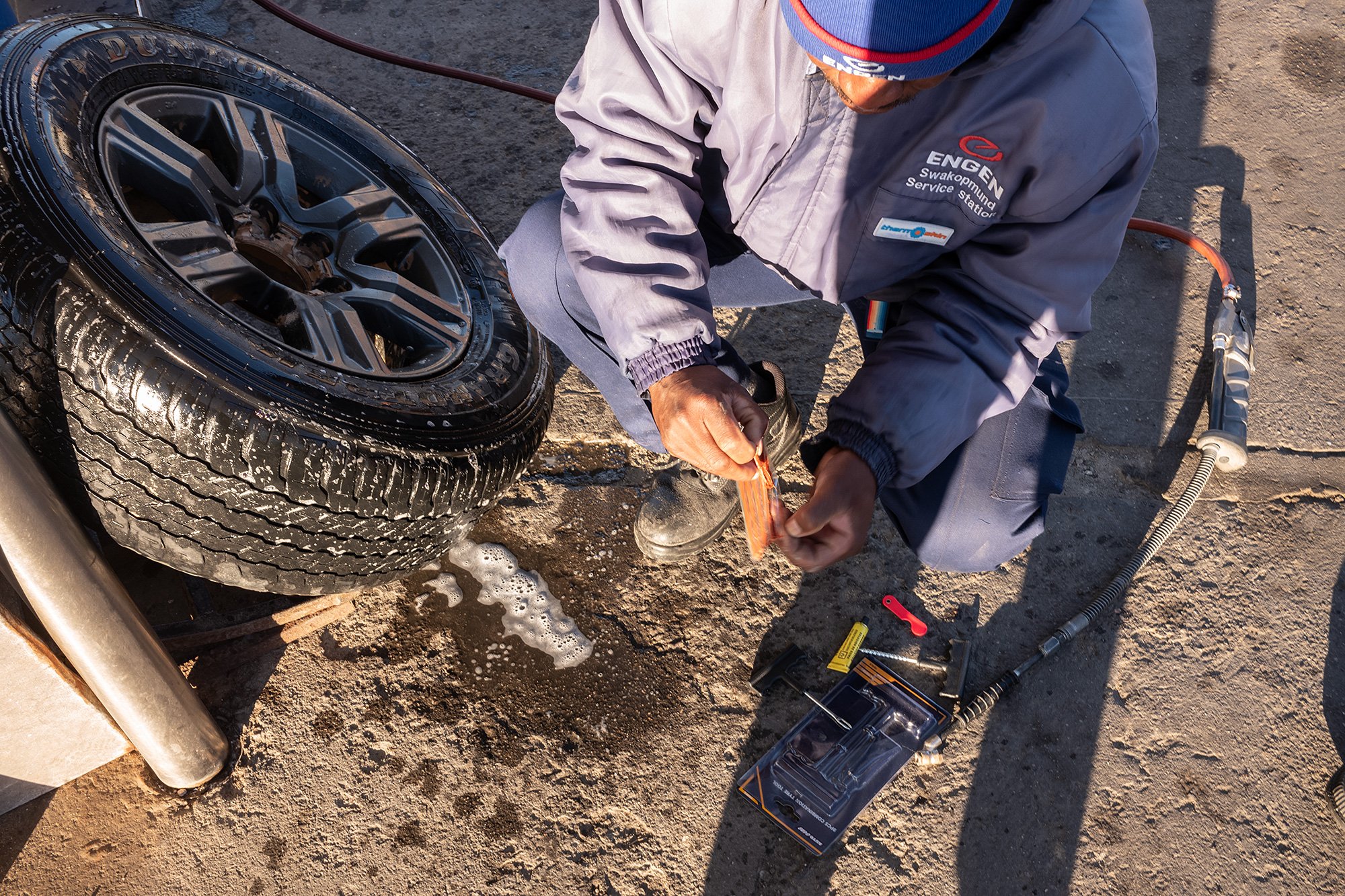
The delay hasn’t been as long as I had feared. I tip the attendants, grateful for their help. It’s still early when I pull out of the station and turn left, headed east towards the so-called Matternhorn of Namibia.


The 120 million-year-old granite peaks of Spitzkoppe lie between Swakopmund and Usakos in the Namib desert off of the B2. It’s impossible to miss as the highest 1,728 meter outcrop juts out dramatically from the plains.
It’s an easy drive on the B2, a nicely-graded dirt road. Cars announce their presence with plumes of dust on the horizon, and it’s sometimes nice to see one far in the distance, a dust cloud approaching and then enveloping me when it passes.
The D1918 is a slightly different story. Patchy and rough in places, the car shudders as it bumps along a road that would benefit from some maintenance.
Nearing Spitskoppe I see what looks like a small town to my right. The GPS tells me to continue on, however, winding me around the back of the area. I follow a dirt road that becomes ever more sandy past a private lodge. A fence runs around the mountains, barring passage. I determine I’ve gone the wrong way around and retrace my path back to the main road and head to the village I had seen.

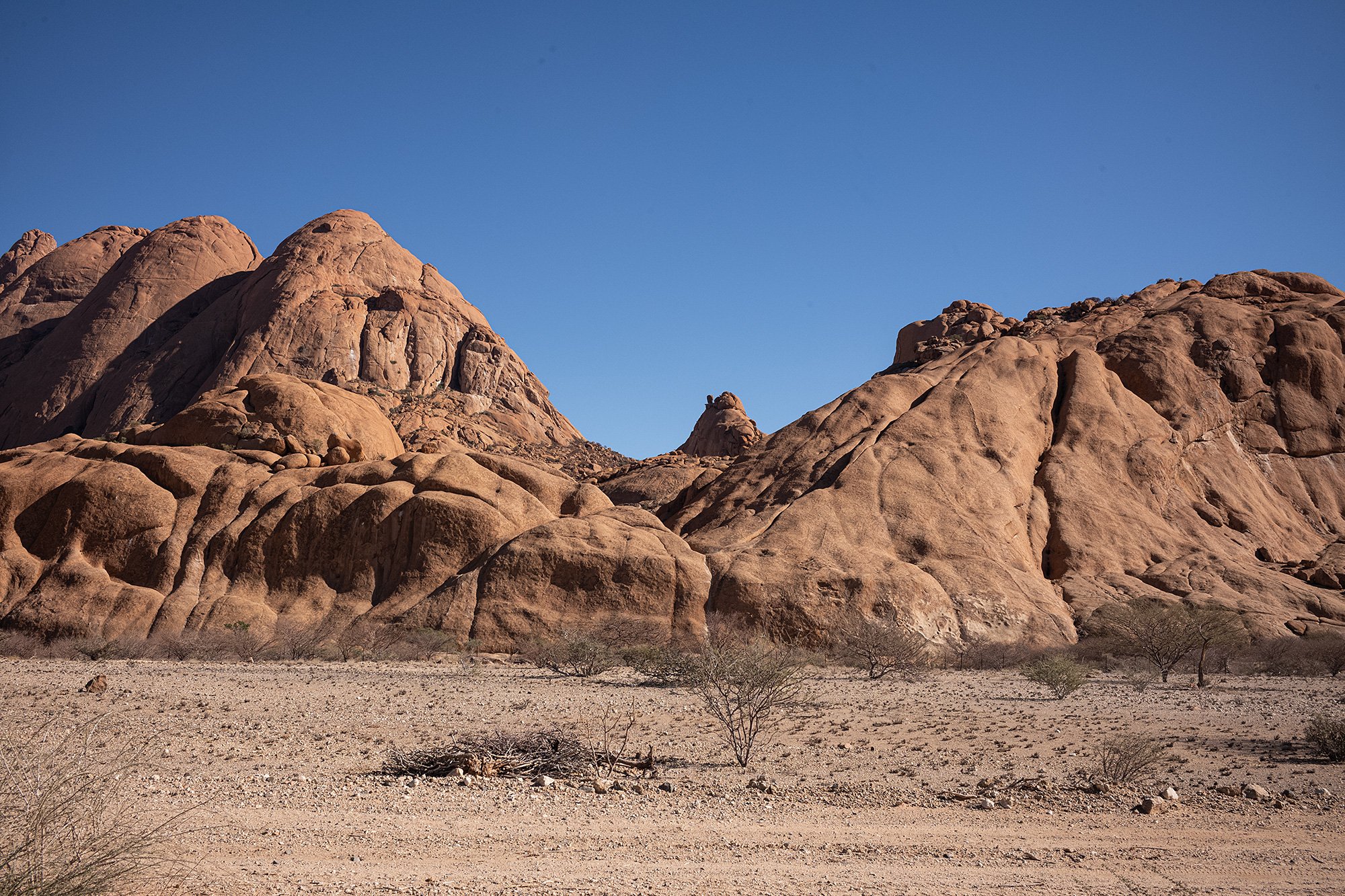

The Spitzkope Community Restcamp marks the entrance to the park. Had I done some research I would have saved myself some time and confusion, but I’ve taken this detour on a whim, letting fellow travelers suggest places I might want to visit on my drive around the country.
I’m given a map and some simple directions. To the left lies a rock bridge, the small bushmen’s paradise (a collection of rock paintings), and a rock pool. To the right is the bushmen’s paradise, another collection of rock paintings nestled in the mountains. It’s reachable by climbing up a rock face, aided by chains. I decide to go right first.
I wind my way around the dirt roads, passing campsites until I find the parking lot for the bridge. A few cars are already parked there and as I climb the smooth surface of a rock to reach the natural arch I see a group of people sitting within it. Other small groups stand around the arch, angling for position, trying to find the perfect crop.

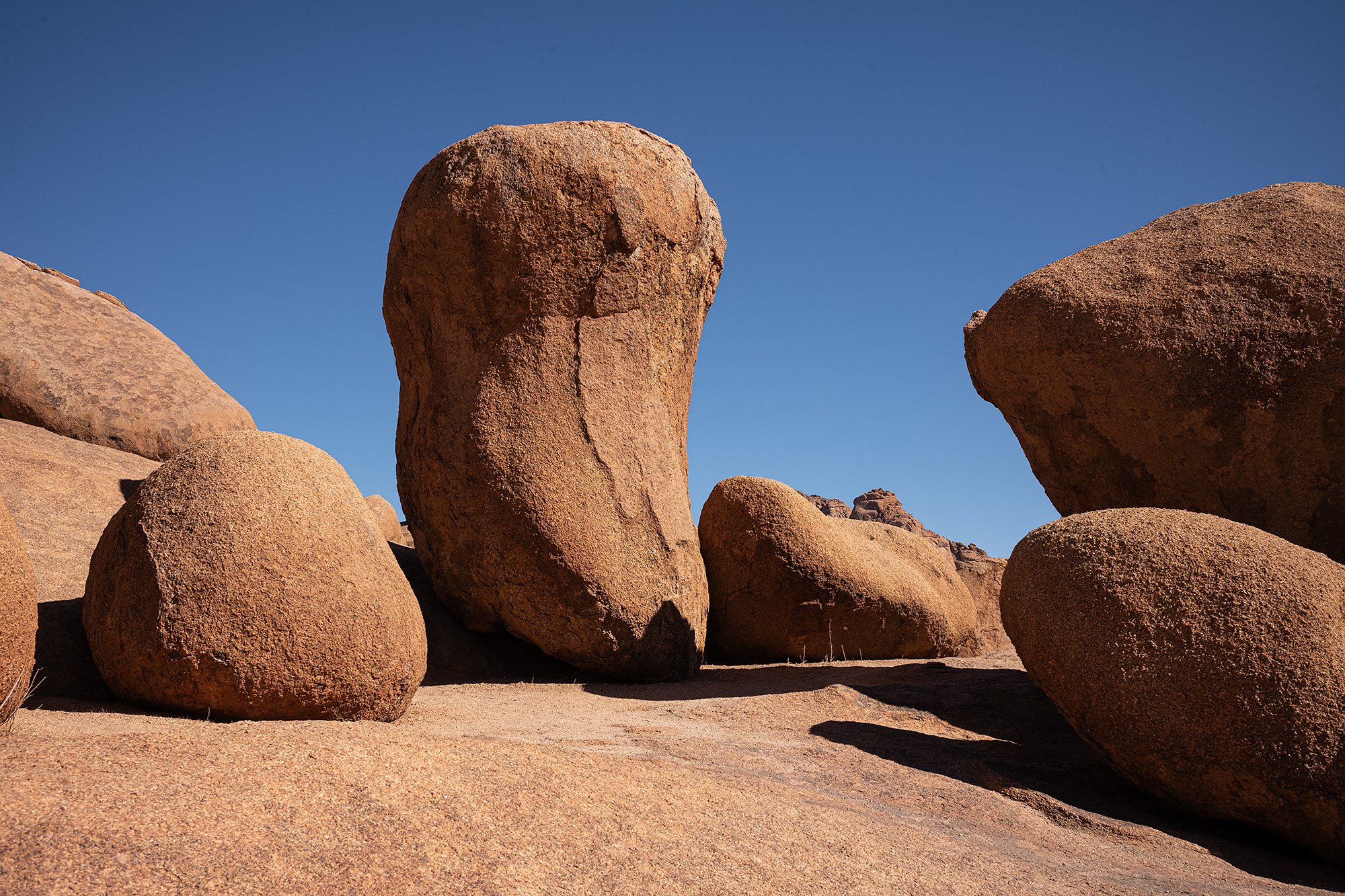
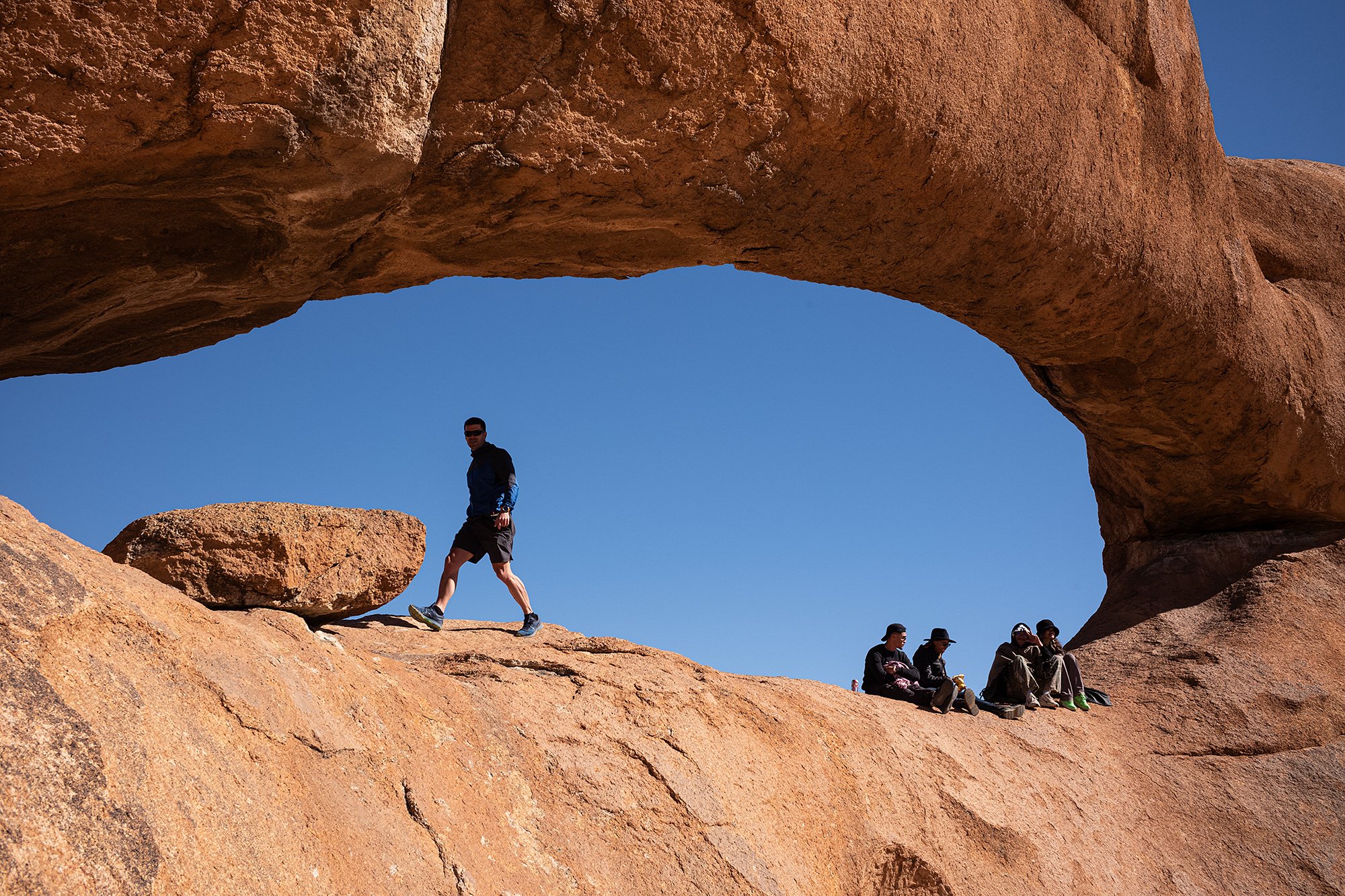

A music festival was held in Spitzkoppe the previous few nights and the majority of the visitors to the park are left over from the festival. The four sitting in the arch look like festival goers, attired in such a way that they wouldn’t be out of place amongst the influencers and Instagram models at Coachella.
I climb up and around them to view the mountains in the background, turning around to take a photo of the arch in such a way as to block them out.


I climb down the back side, surrounded by huge boulders that block out the views. I feel dwarfed in such a way that is far beyond what I felt in Giant’s Playground.

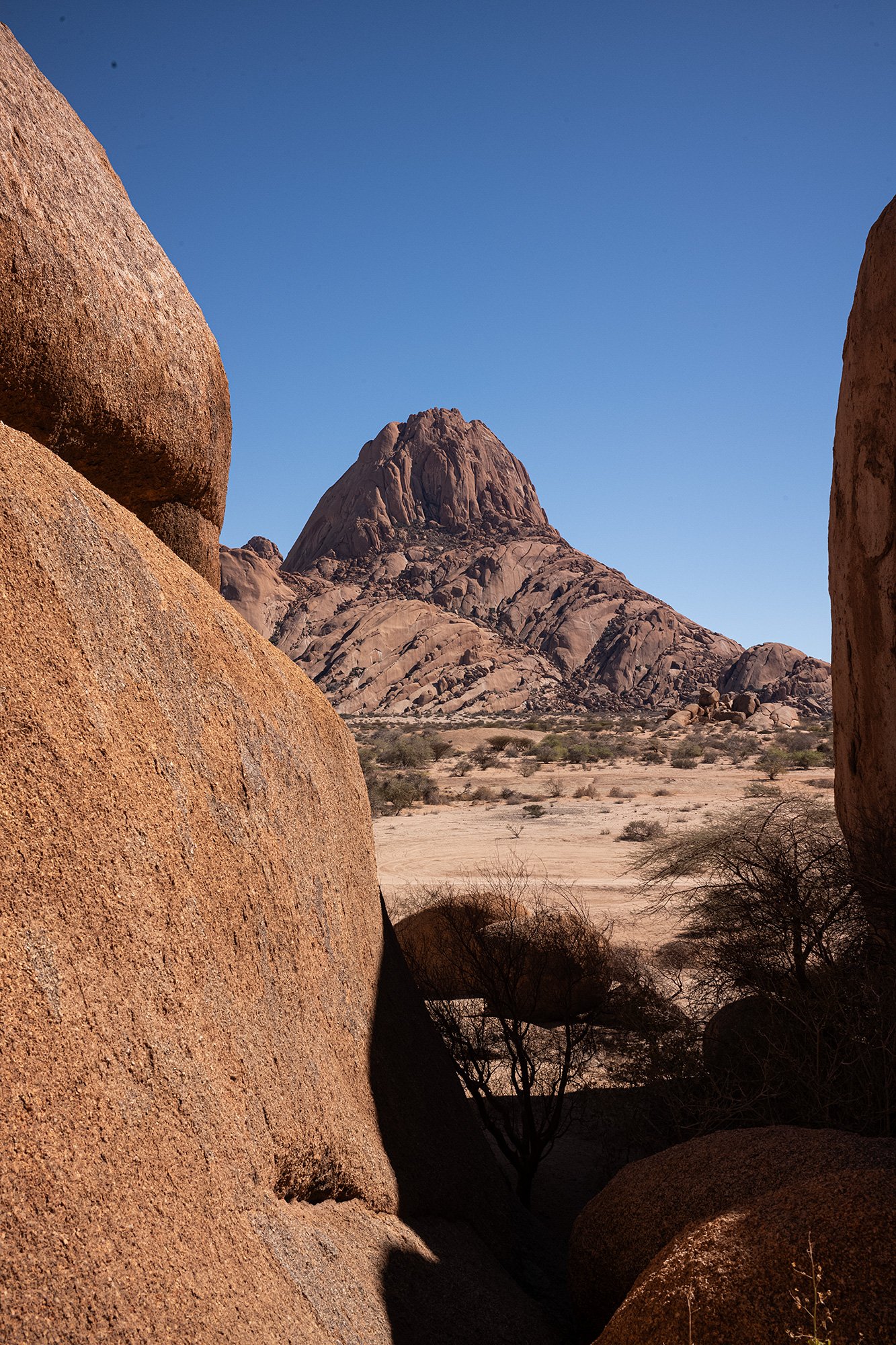
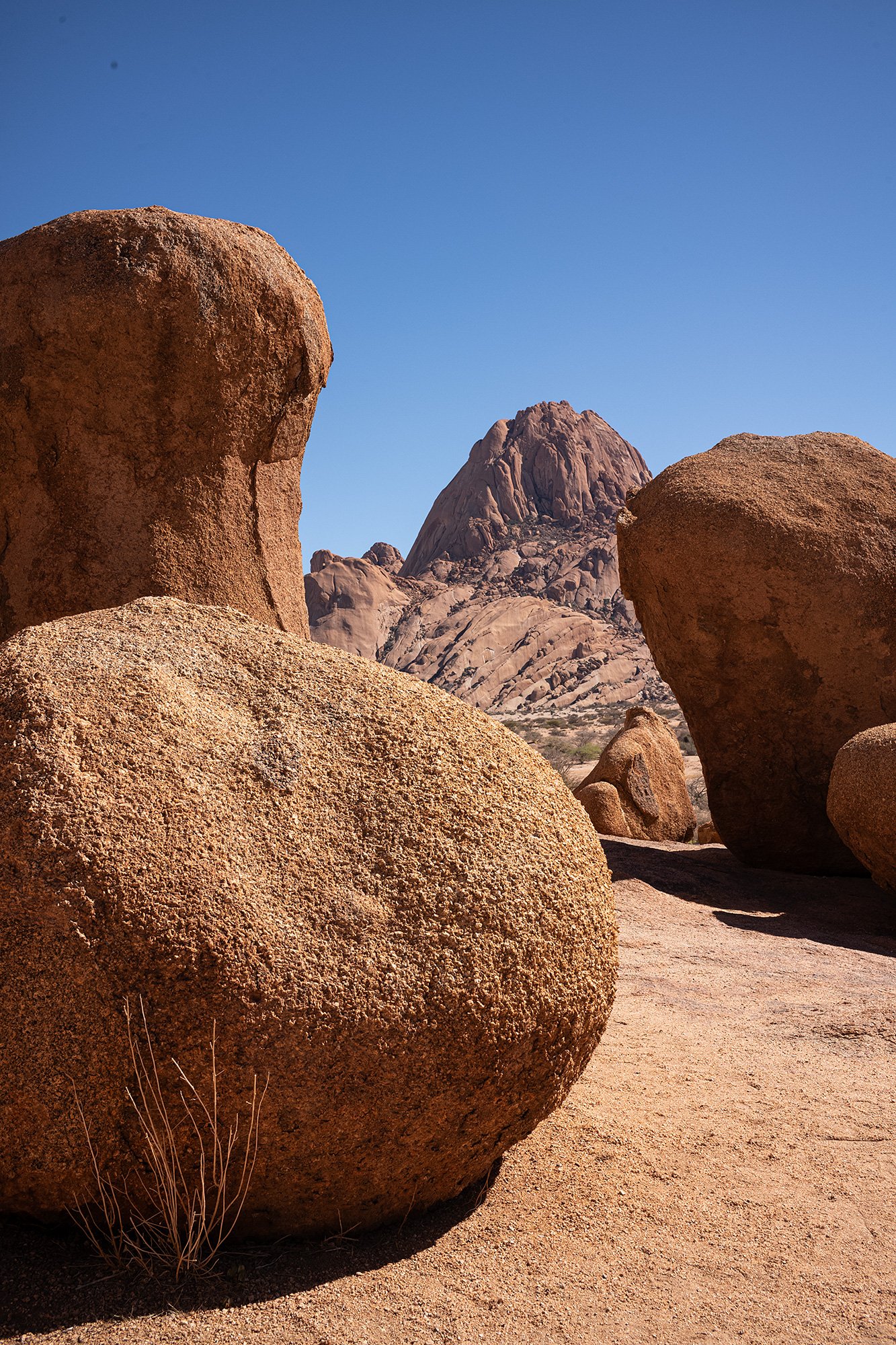
Back in the car I drive around in search of the nearby rock pools without success. I give up and head to the secluded little bushman’s camp. There, Randall meets me and offers to show me the paintings. He unlocks a metal gate and leads me into the enclosure, pointing out the faded paintings on the rocks. He also explains the click language, writing out the click consonants in the sand. He demonstrates and encourages me to try. I do my best, managing one or two; the other two are beyond me.
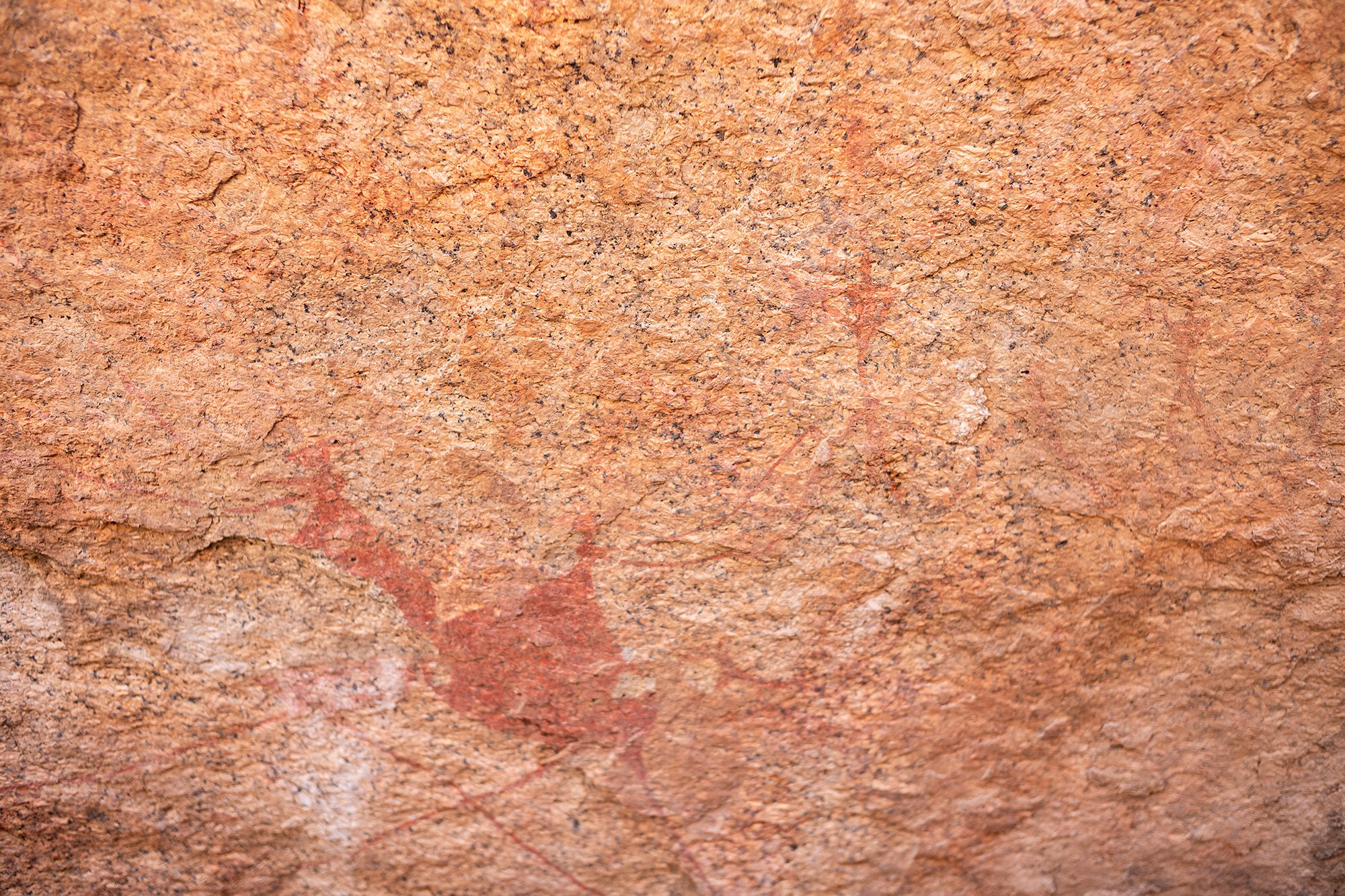

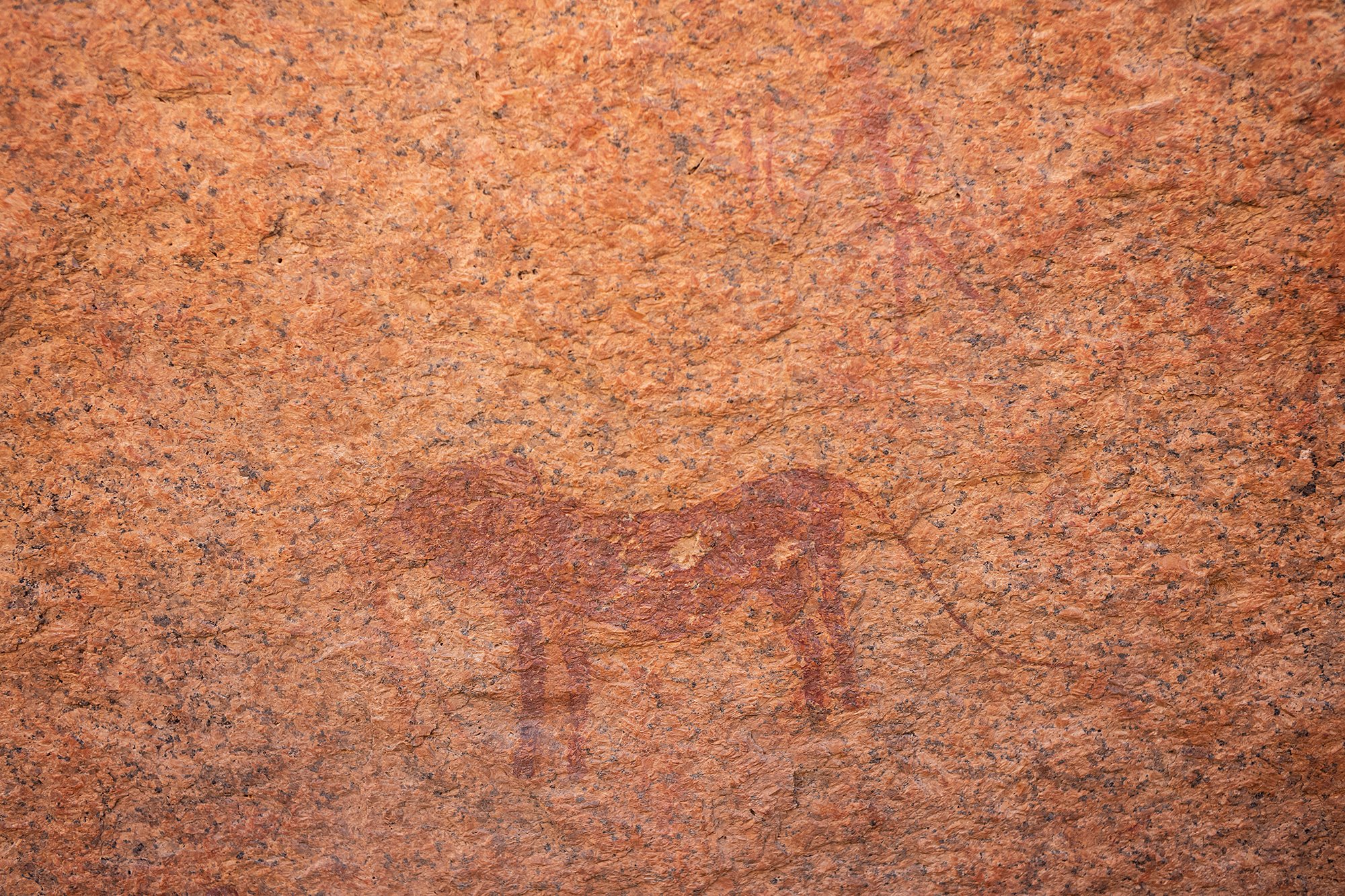
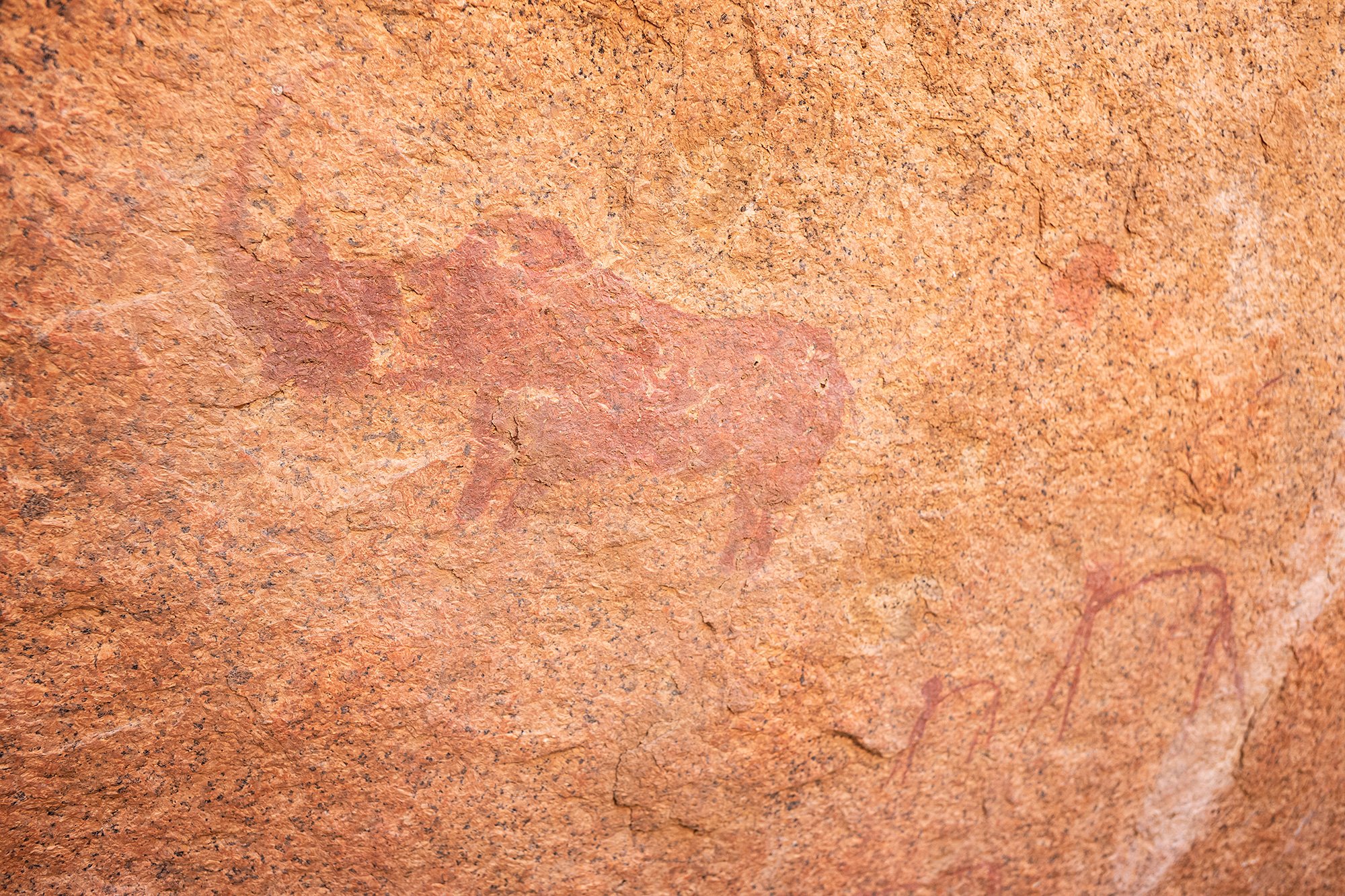
Perhaps the most surprising (and my favorite) is one of an octopus. Randall tells me the San were a nomadic people, traversing the desert to the sea and back. The octopus is proof.
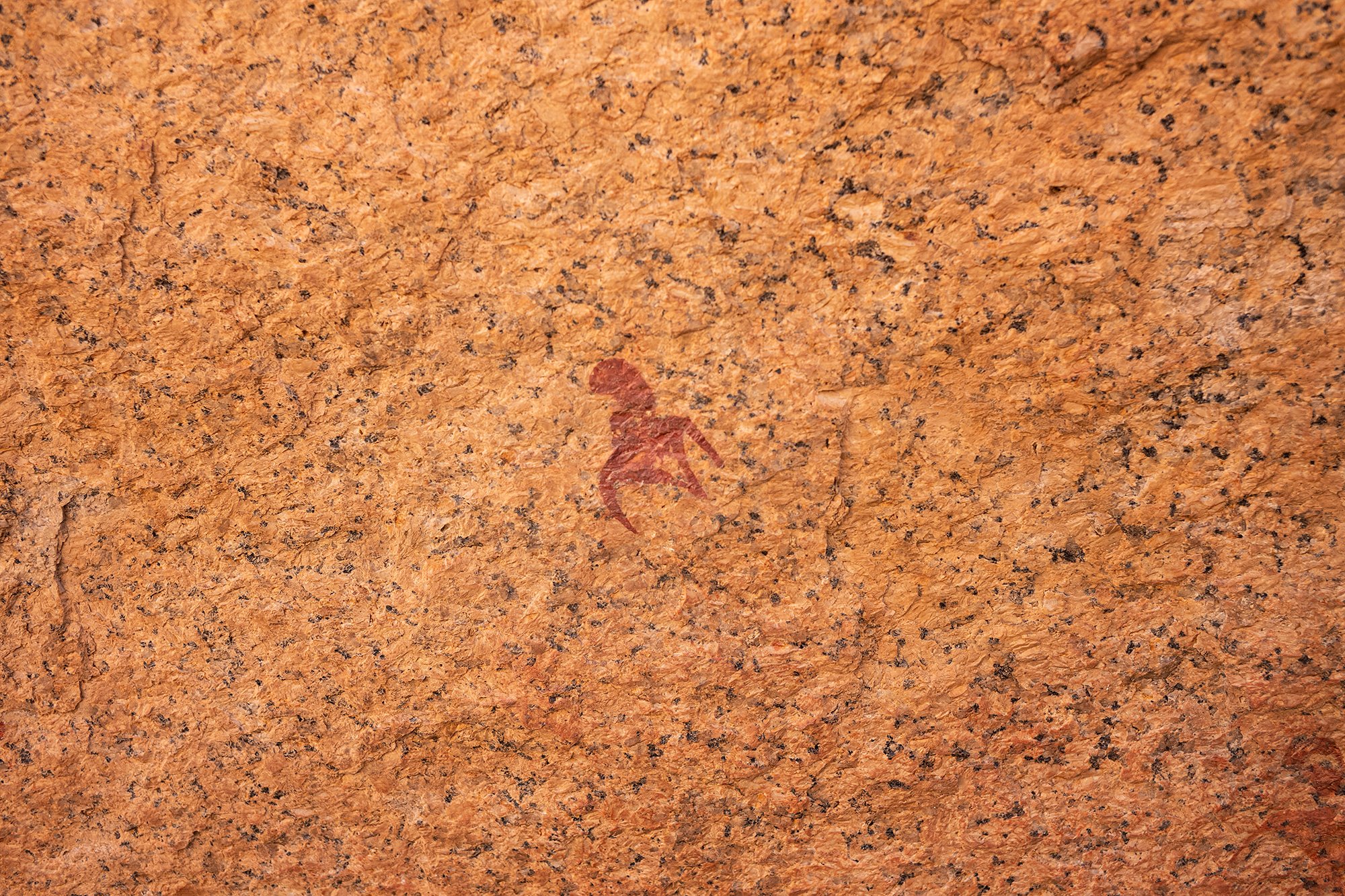
I ask Randall where the rock pools are and he points to a rock not far away to the south where I had just been. He tells me the pool is mostly dry, but that if I park at camp two it’s an easy climb up to the top.
He asks me if I’ve been to the chains. I tell him I haven’t yet and was debating whether to take the time. He tells me the views from the top are amazing. He makes the decision for me.
I drive to camp two to search out the pools. As Randall mentioned, it’s mostly dried up, though I can see the mineral deposits that mark the high water point.

Jeremy meets me as I alight from the car at the second bushman’s camp. He waits in a small shed by the chains that lead up the rock to the rock paintings. Another truck has been circling and he asks if I mind waiting to see if the passengers want to join us. I don’t mind.
He walks over to them and comes back alone. Let’s go, he says. I grab hold of the chains and start climbing. He walks unassisted beside me.
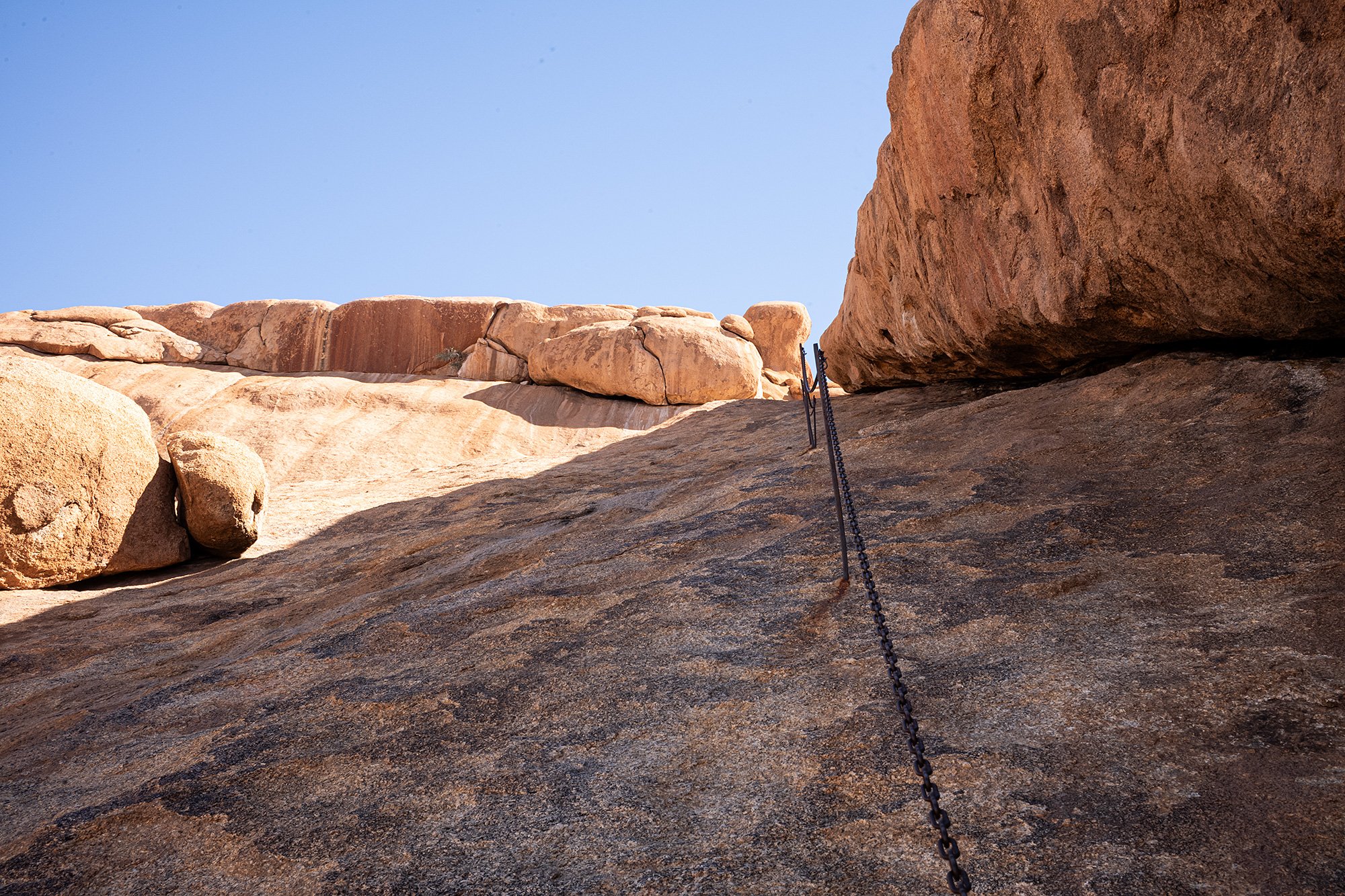
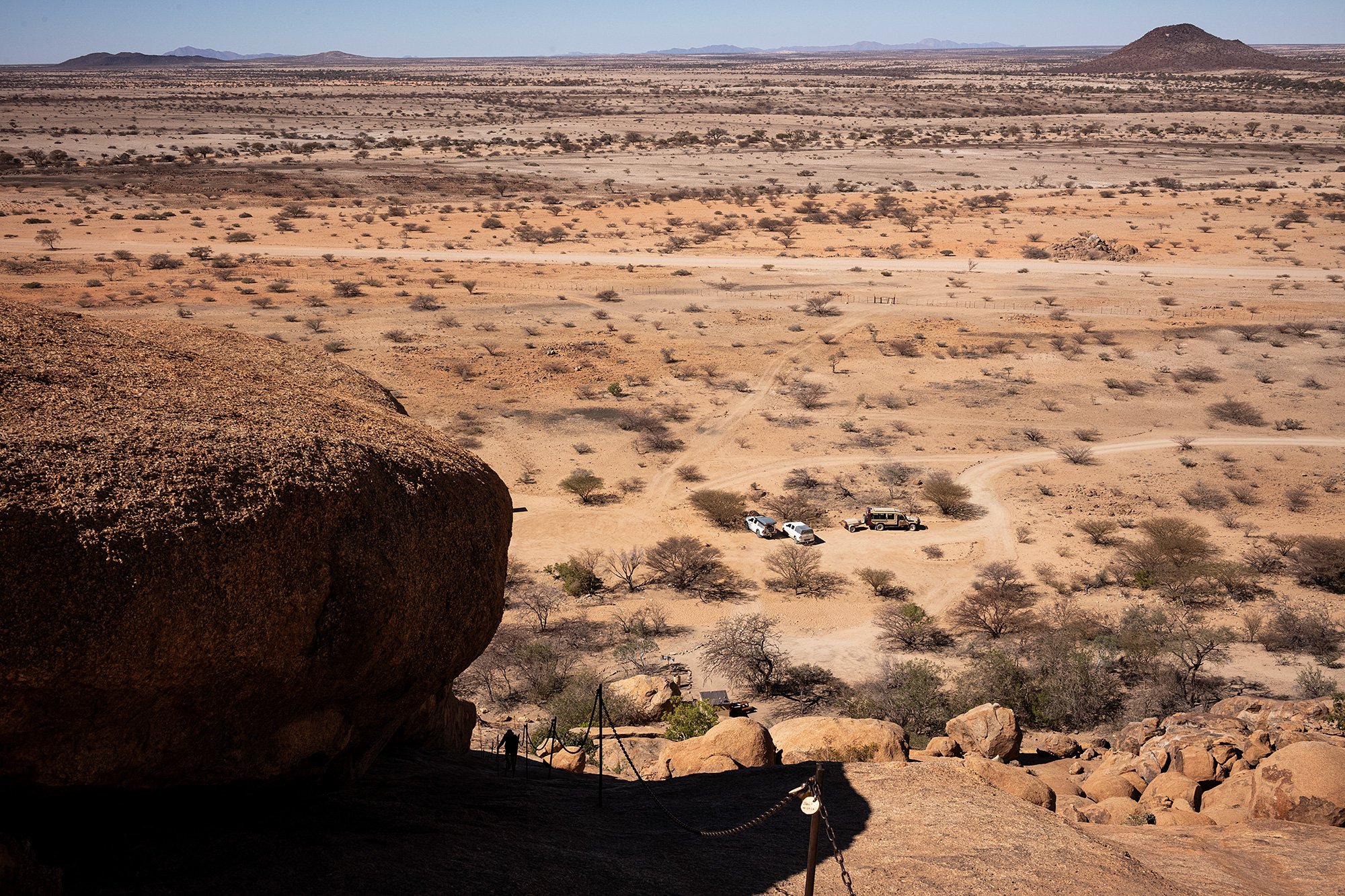
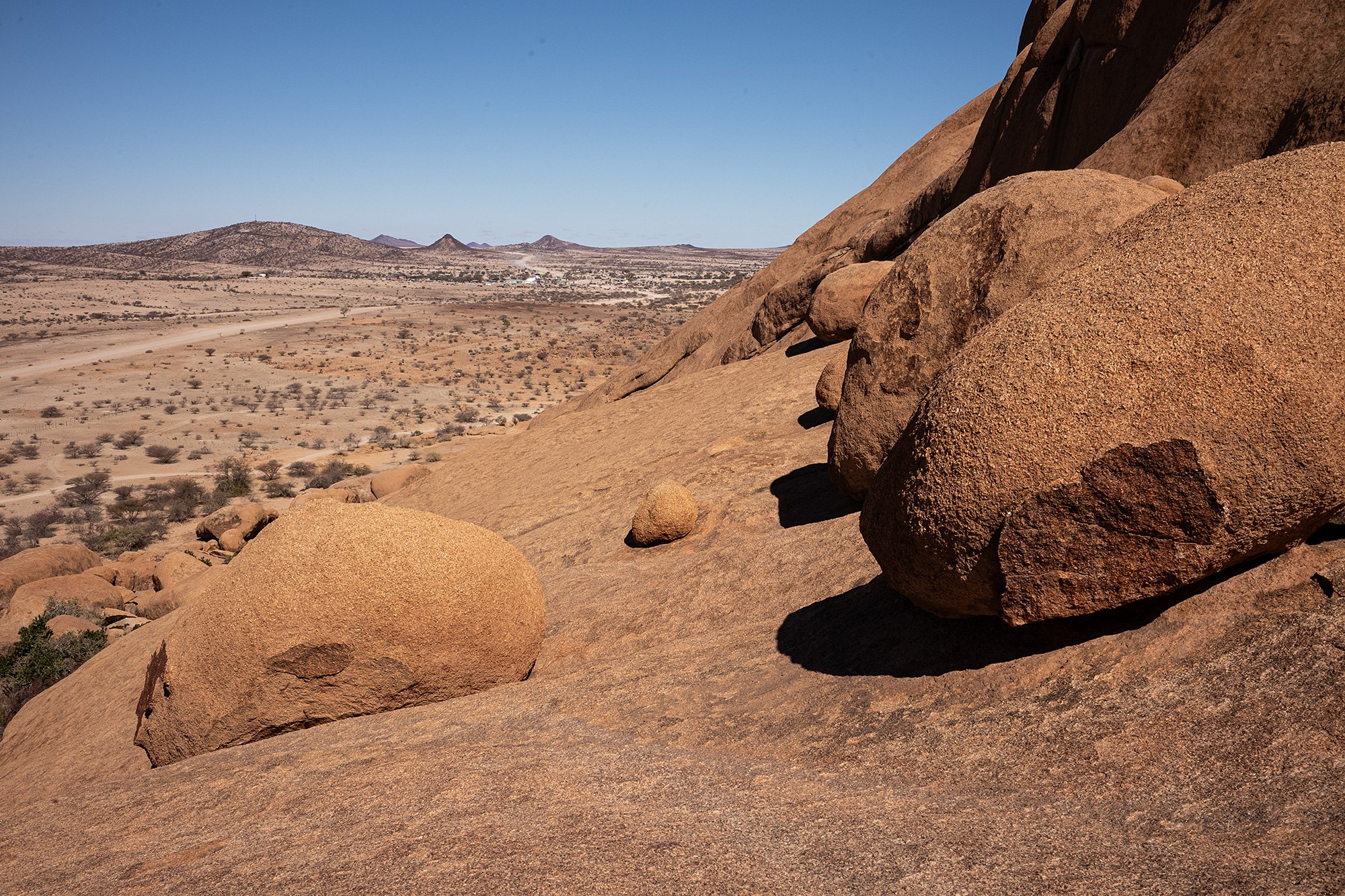

Reaching the top, we rest overlooking a small bowl set in the rocks. A small group is heading towards the paintings and Jeremy chooses not to crowd them. He encourages me to drink water.
We talk about movies. We swap favorites and he recommends a few action films to me.
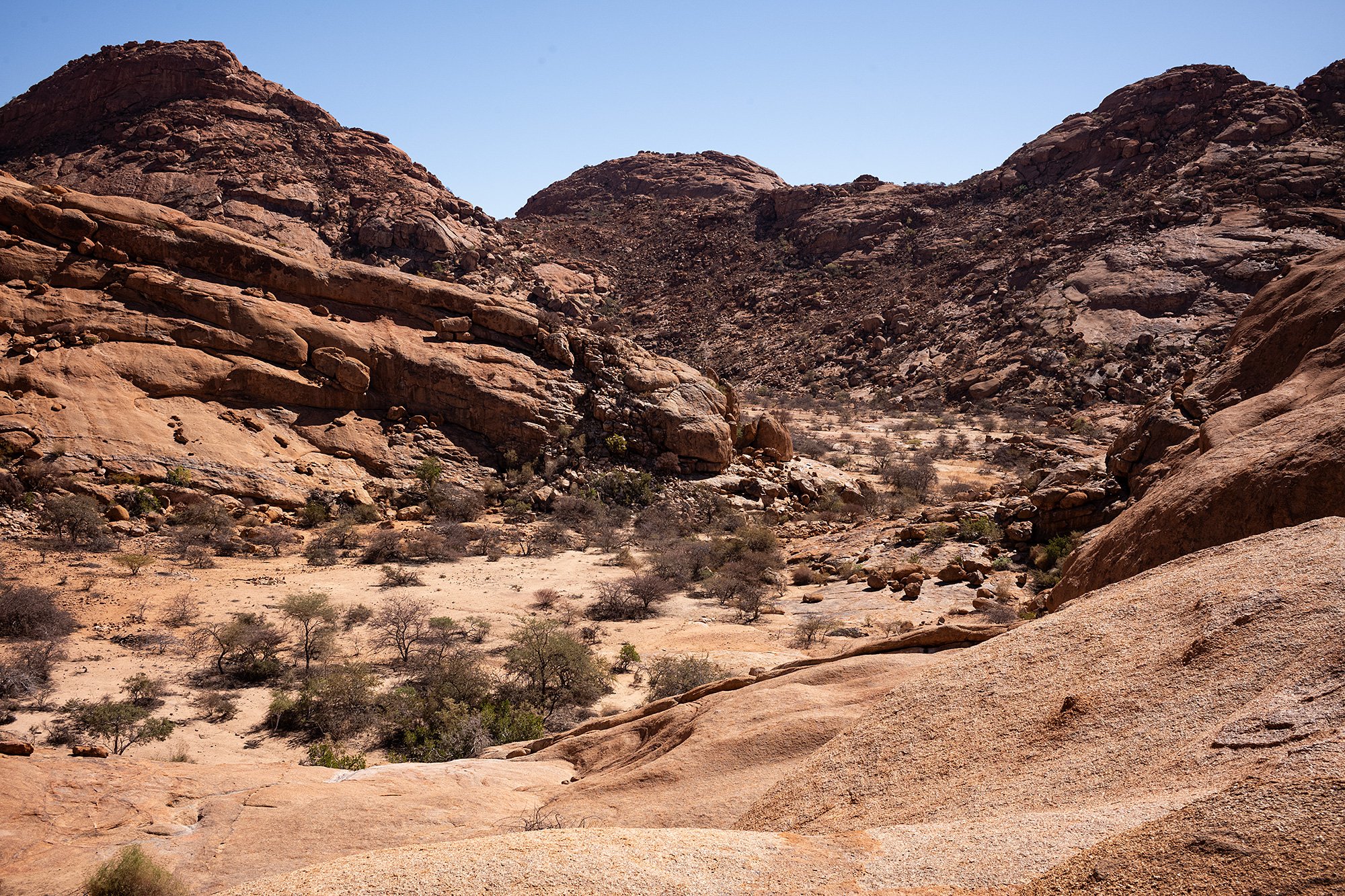
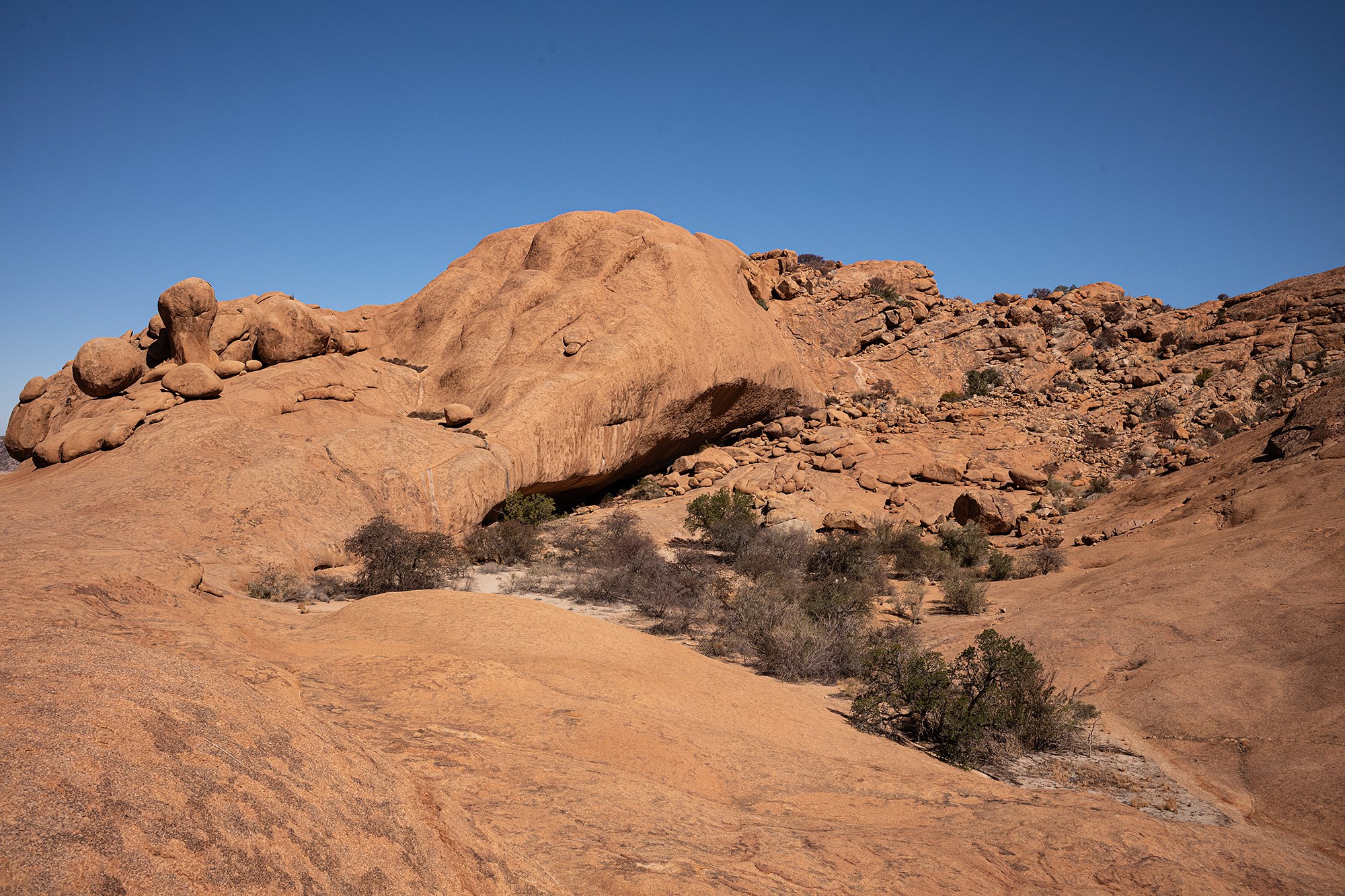
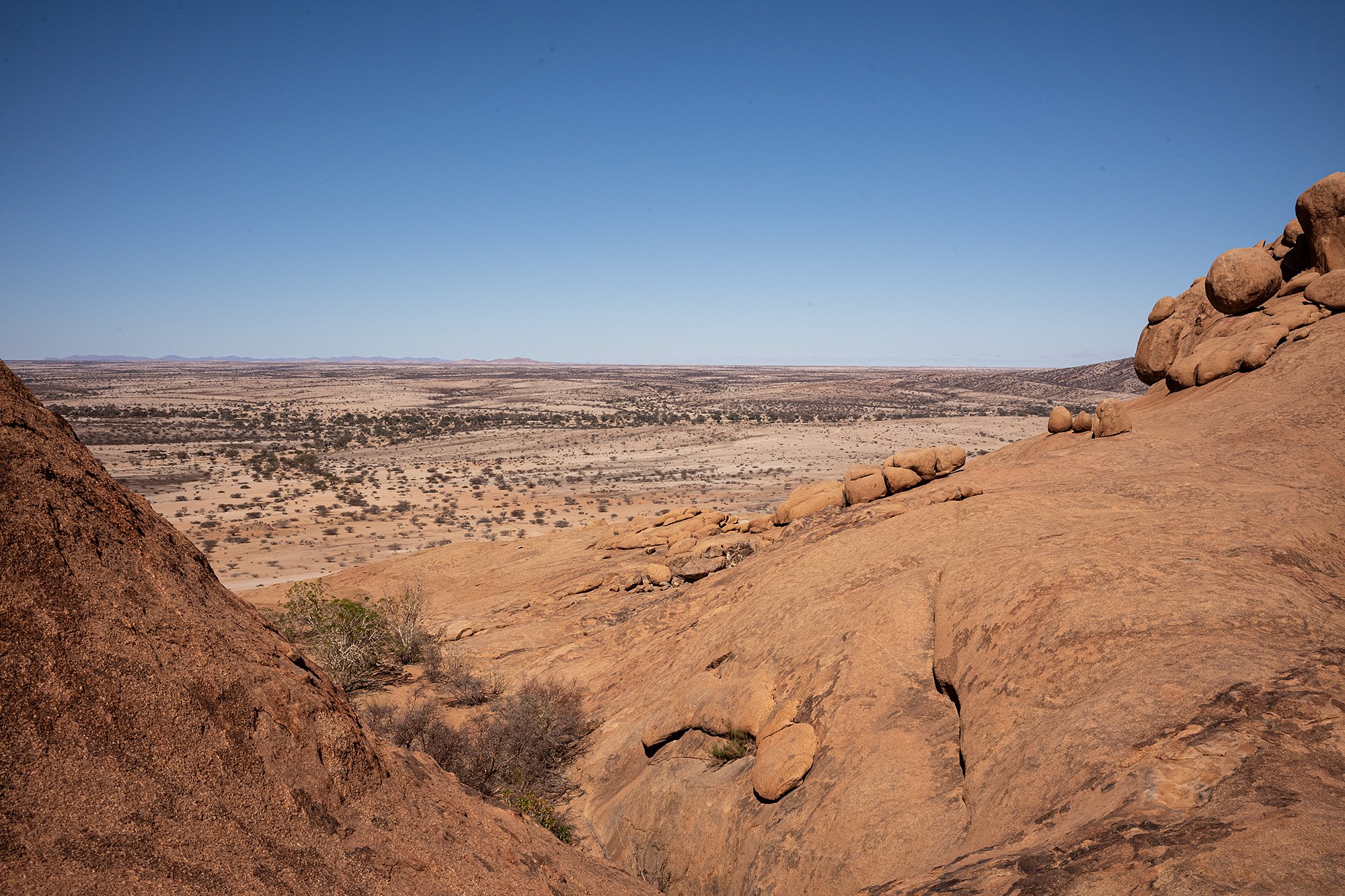
Once the other group has moved on he leads me to the paintings, set under an overhanging rock. They’re faded and some are hard to make out, but it’s incredible to be in the presence of art created thousands of years ago. I think about the hands that drew the figures, the lives led, the impetus to paint.
My best friend recently sent me a video of their baby laughing. I asked if they knew why they laughed or what they were doing. My friend said it’s natural. They learn to laugh and clap and don’t even know why. Is the desire to make art, to document our surroundings in images a natural part of ourselves? What compels us (me) to write and to photograph and to share?



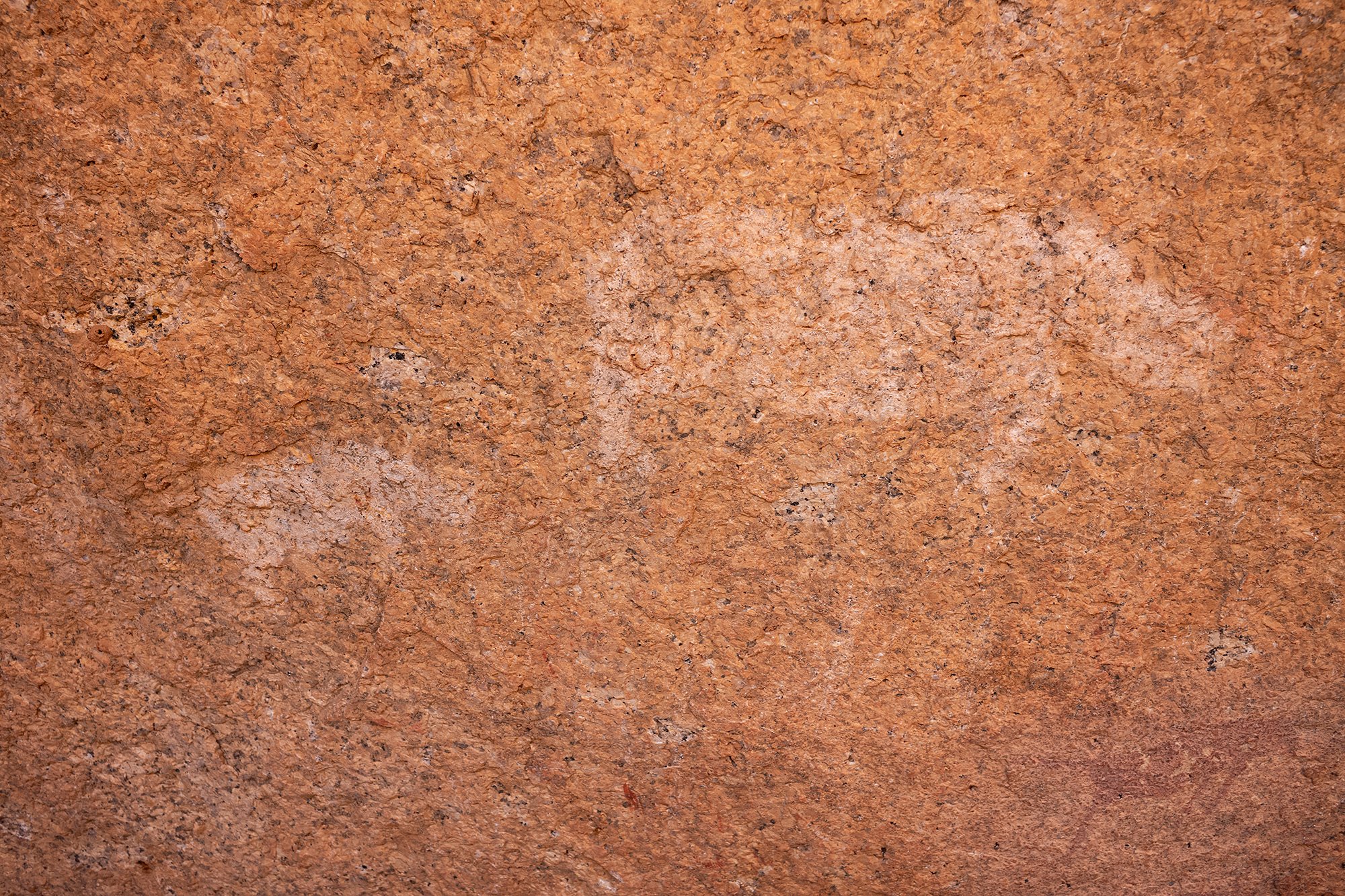
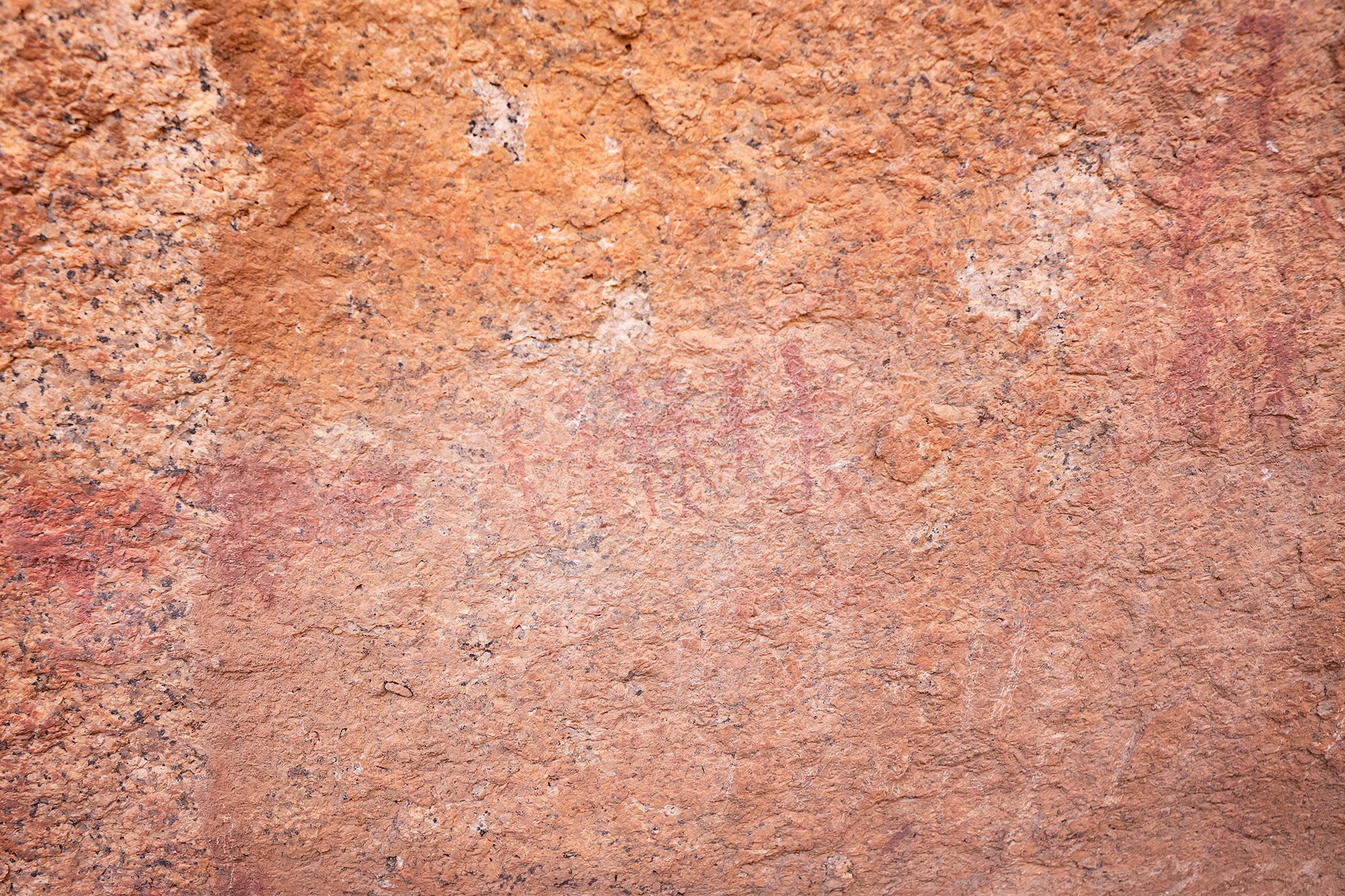
Jeremy leads me back to the edge of the rocks to begin our descent. I make sure to keep a grip on the chains as I walk down the smooth slope. Randall walks ahead, unencumbered, his steps sure.
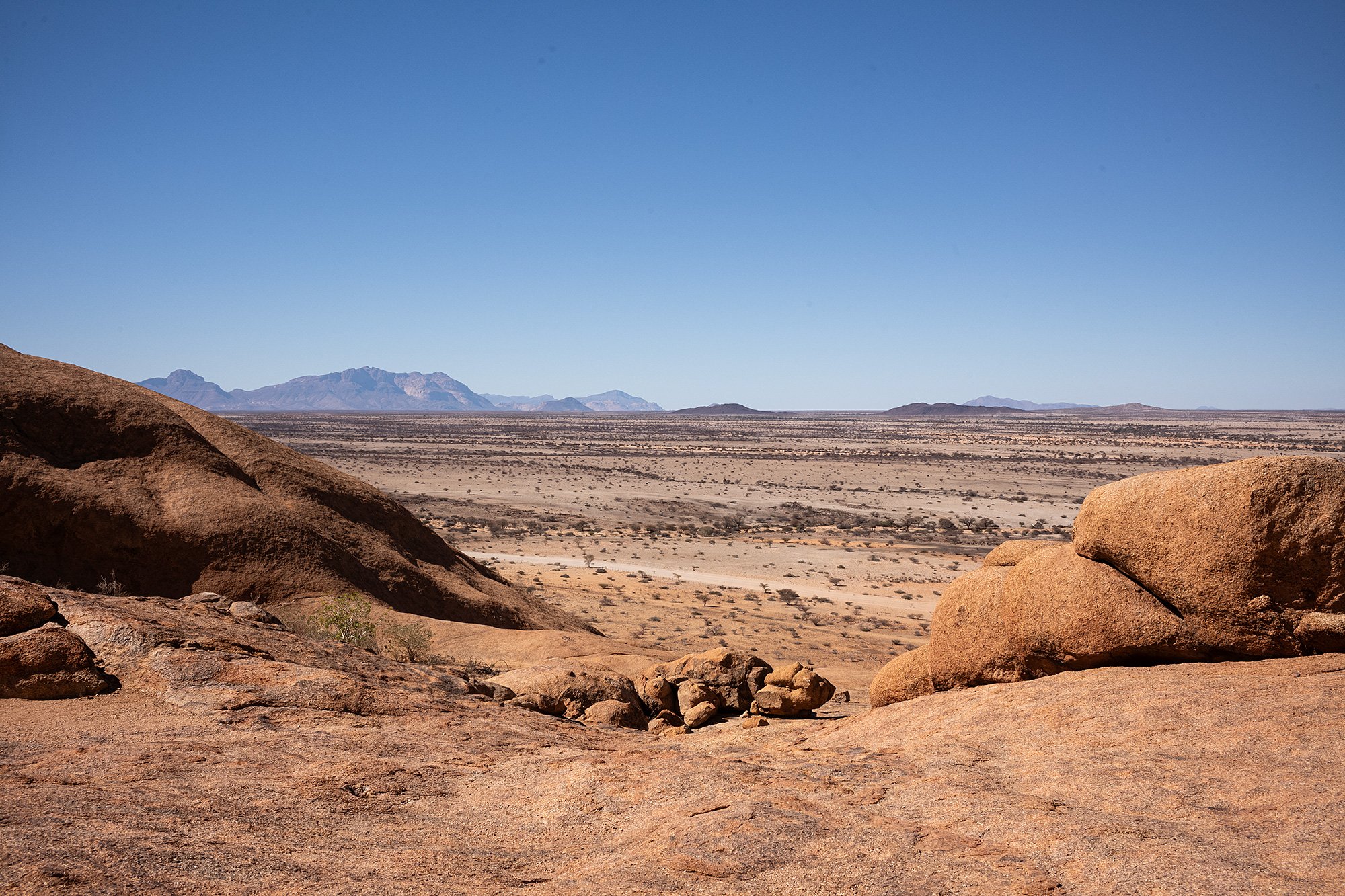

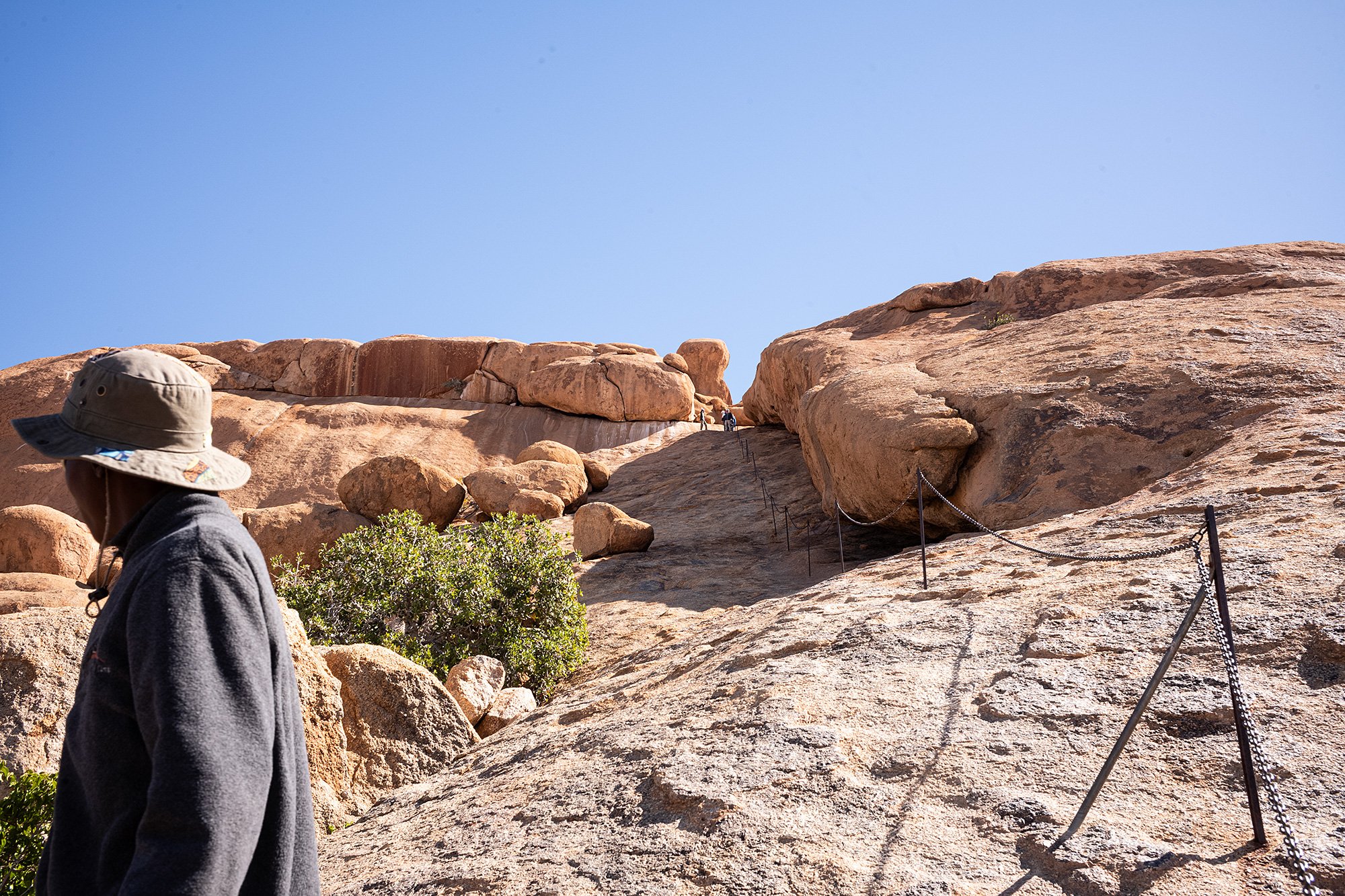
An older group has arrived. A man waits by their van. He’s their guide, guarding their car and mine. There’s not really much to worry about, but with the festival there are more people about than usual. He tells me he’s been coming to this area since he was a kid, before the chains had been set up and before it had become such a popular destination.
We watch his group of guests as they make their way down the rocks. He excuses himself when they arrive, and I bid him adieu as I settle into my car and prepare for the drive to my next destination.
There are two ways forward, one backtracking and one zig-zagging over unfamiliar roads. Given the poor condition of the road to Spitzkoppe, I elect to retrace my steps, somewhat concerened that the other road may be worse (and less-traveled). There’s also a place to stop for gas.
I stop in Usako to fill up my tank. While driving towards the center I spot a tower that appears and disappears between the buildings. It looks like the spire of a castle or the cap to a church spire and I go in search of it. It turns out to be a water tower. I laugh at my imagination and drive back through town to turn off onto the D1935 headed north.

William greets me by at the gate to the Hohenstein Lodge. He checks my name and radios ahead to announce my arrival.
Anatolia checks me in and fills me in on the daily schedule of meals and activities. I ask about drives around the property and she tells me that they leave at 15h30. I tell her I’d love to book it. It’s 15h and I head to my room to prepare.
It’s tea time and fresh warm chocolate cake is being served. I haven’t eaten lunch and I quickly scarf down two slices as I make my way to the waiting Landcruiser to begin my drive around the foothills of the Erongo massif.
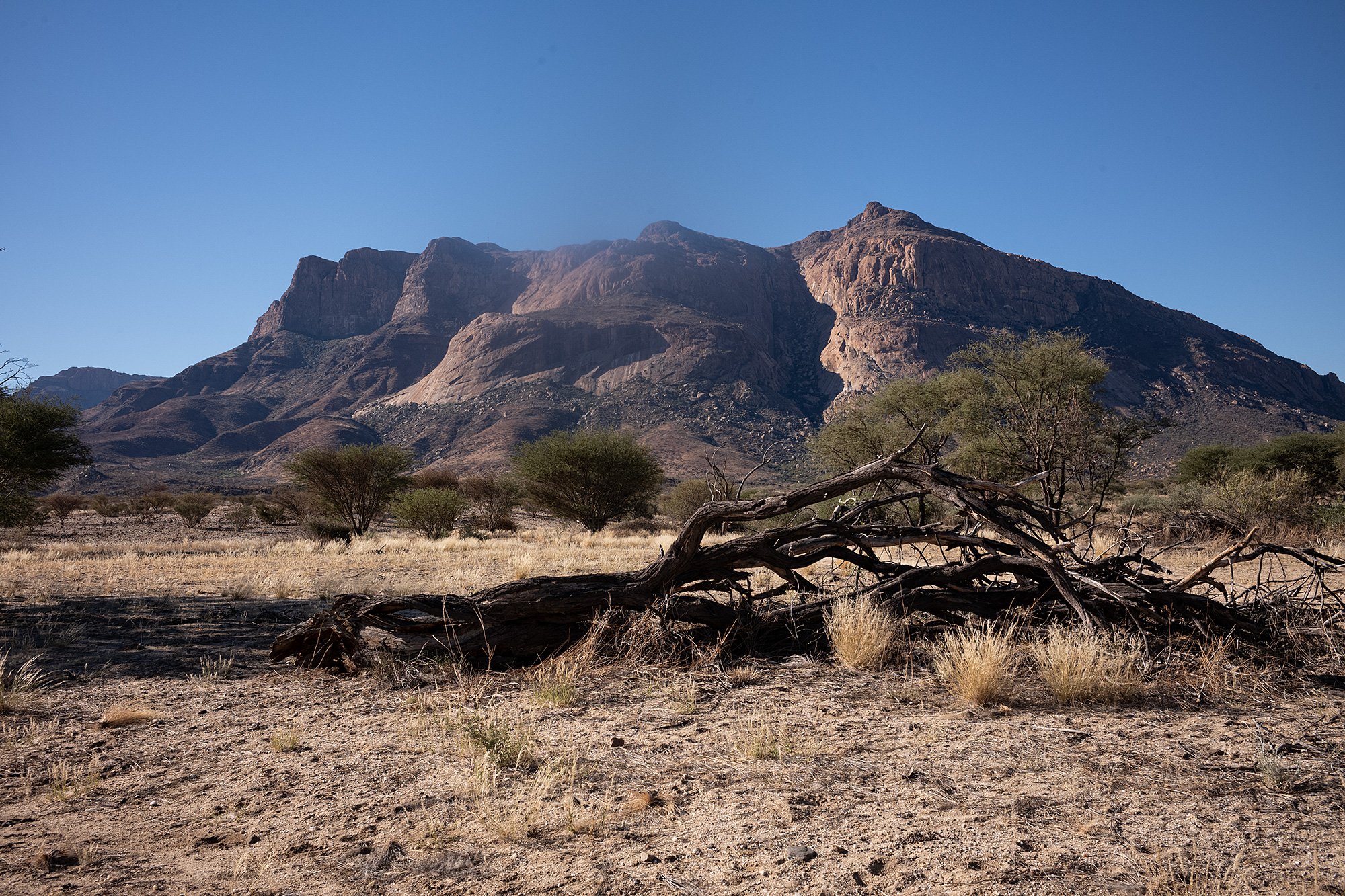
Approaching the mountains we spot a small herd of springbok in the bush. Kudu linger nearby, wandering away from the vehicle. No one seems to mind our presence, but none are eager to reveal themselves either.
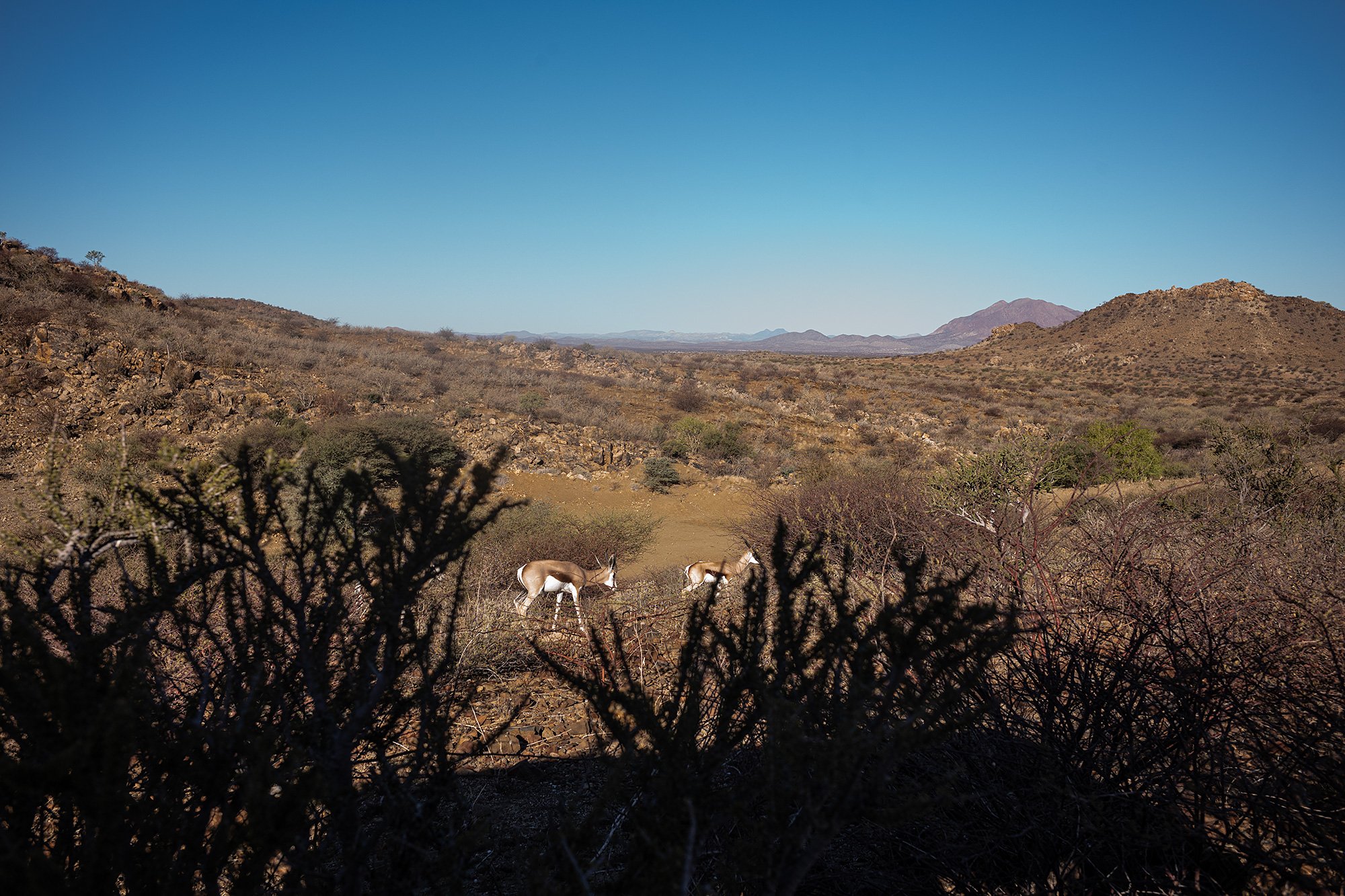
We continue driving around the property. I admire the landscape as the guide points out flora and fauna. He points out the shepherd tree, which has deep roots underground and white trunks. He tells me that the leaves are always green and that it provides sweet fruit.
He tells me about the basalt and quartz rock that make up the massif, later telling me that there are people who mine the rocks above. I ask if it’s possible to climb the mountain. He tells me that they used to run trips before Covid but have yet to resume them.
At one point we alight from the vehicle and do a short hike to a site of San rock paintings. He tells me that blood and ostrich shells were used as ink for the paintings and points out a bush that seems to grow straight out of the rock. He then points out the roots that have traveled through the rock down at the base, tunneling into the sand.
He tells me the paintings are not more than 2000 years old. They were discovered in 1940-1950.
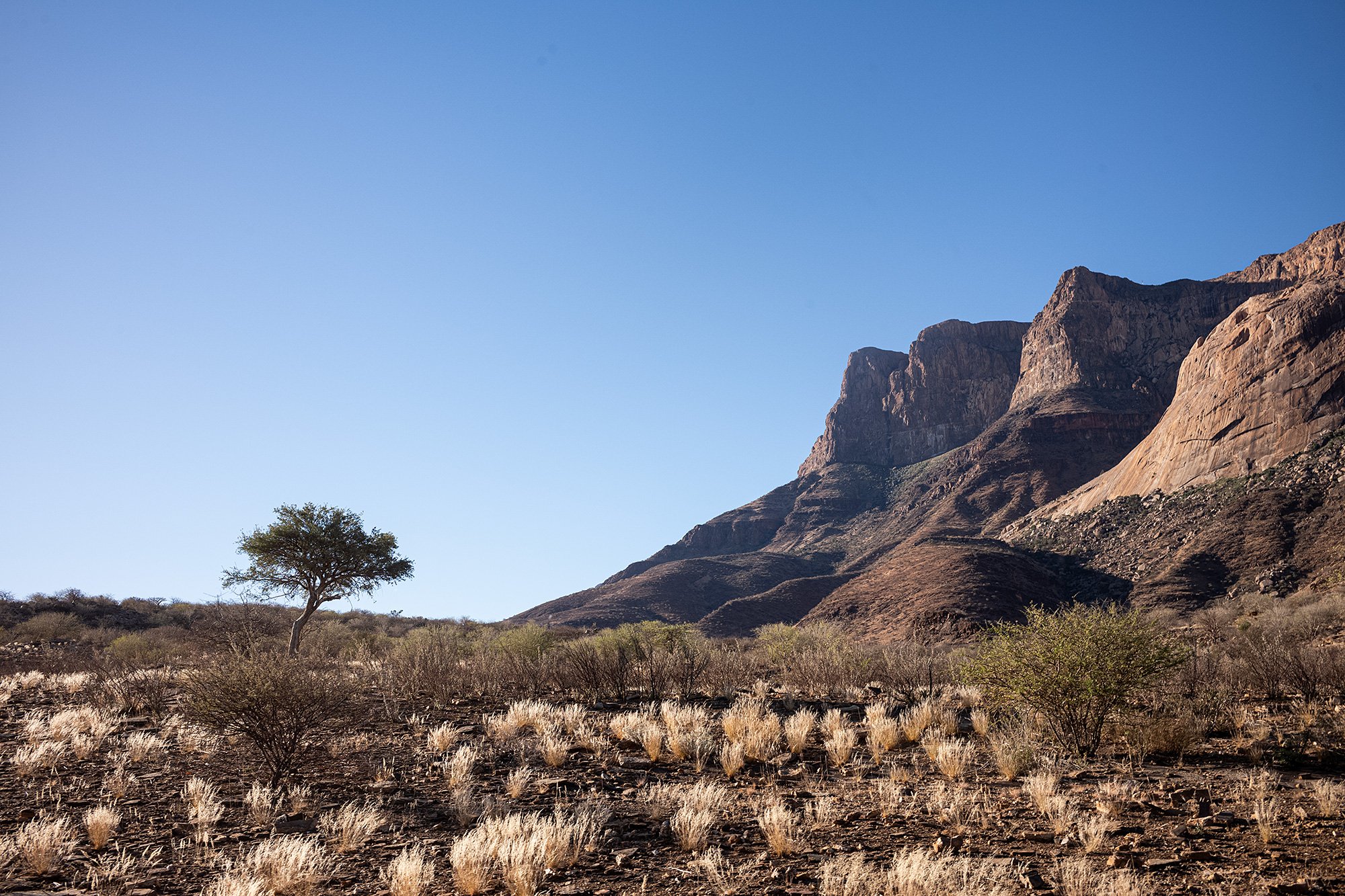
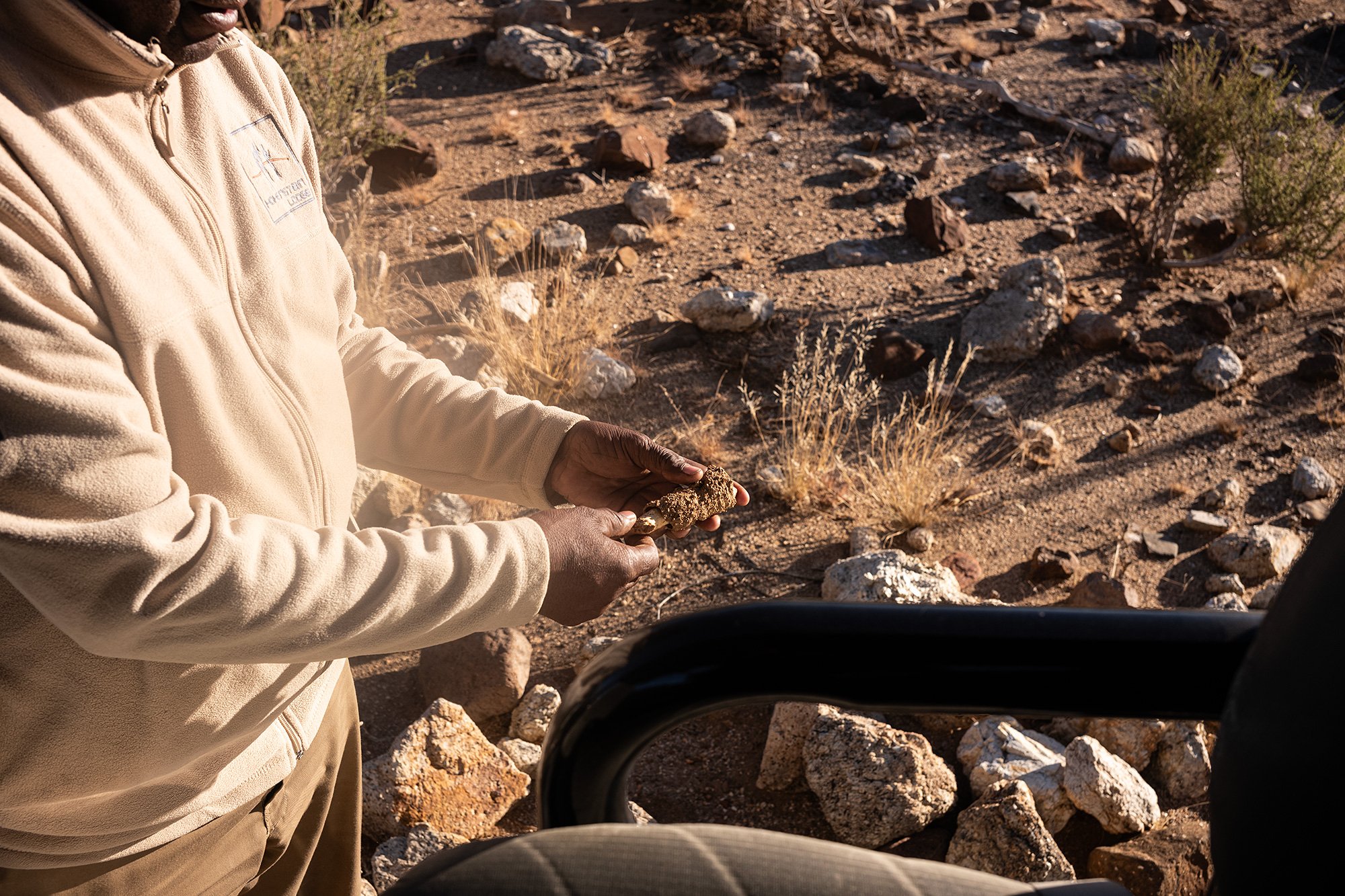


We drive up a small hill and unload snacks and drinks. I ask for a G&T and walk around the area to admire the landscape.


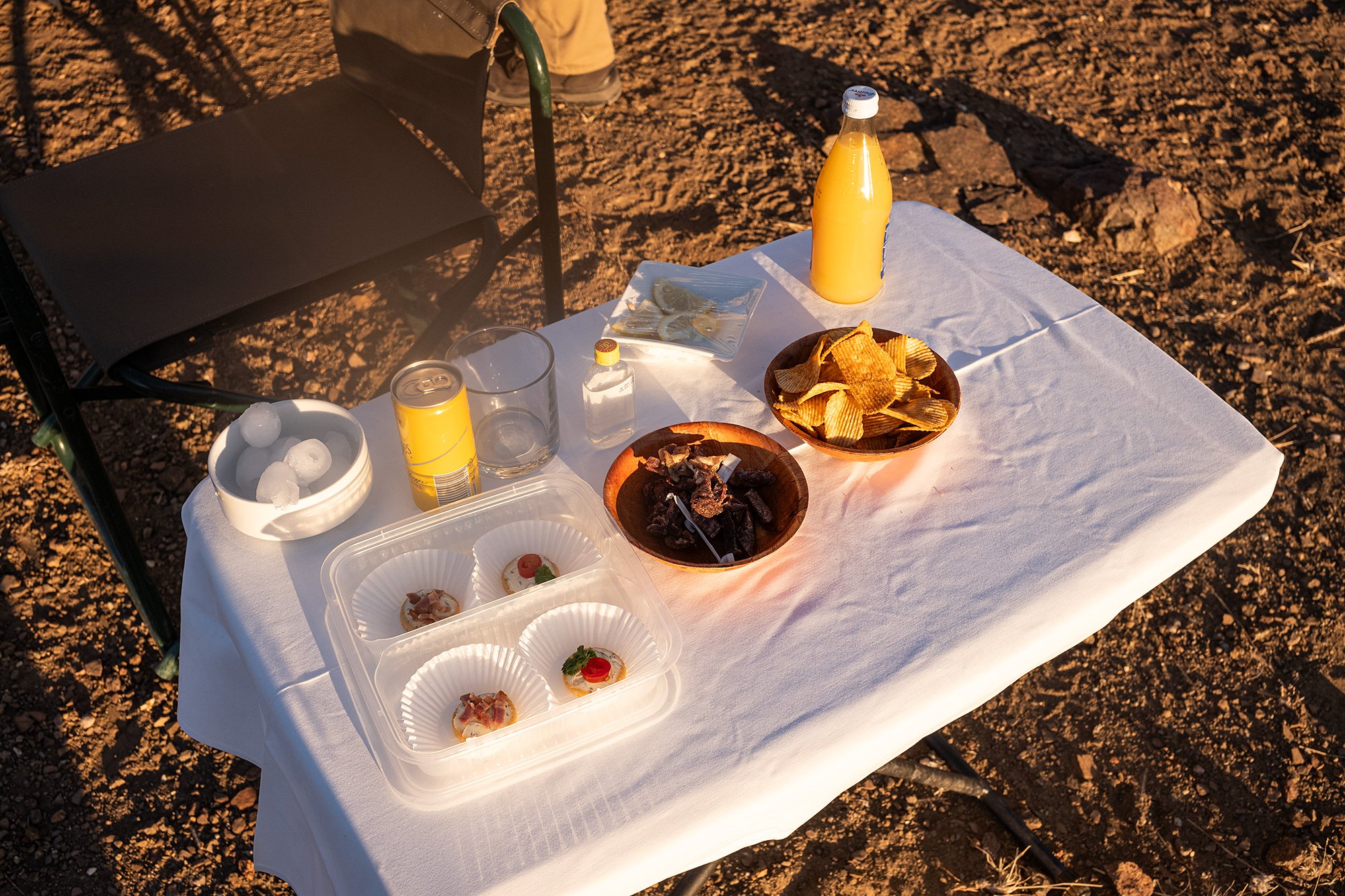

Back at the lodge I stand outside by a fire that has been lit for braai. The warmth of the day has dissipated, and the drive back to the lodge has left me cold. They tell me they’re going to collect firewood for the common area. I mishear them and ask if there are fireplaces in the rooms. Noooo, they say, smiling. Wishful thinking on my part.
Dinner is delicious: mixed braai, butternut squash soup, and malva pudding for dessert. The dining room is warm with a fire burning in the corner. I’m loathe to leave but want to get up early in the morning. It’s at least a four-hour drive to Doro Nawas and I want to arrive with enough time to arrange an afternoon activity. The road beckons. 🇳🇦
2 June 2024
